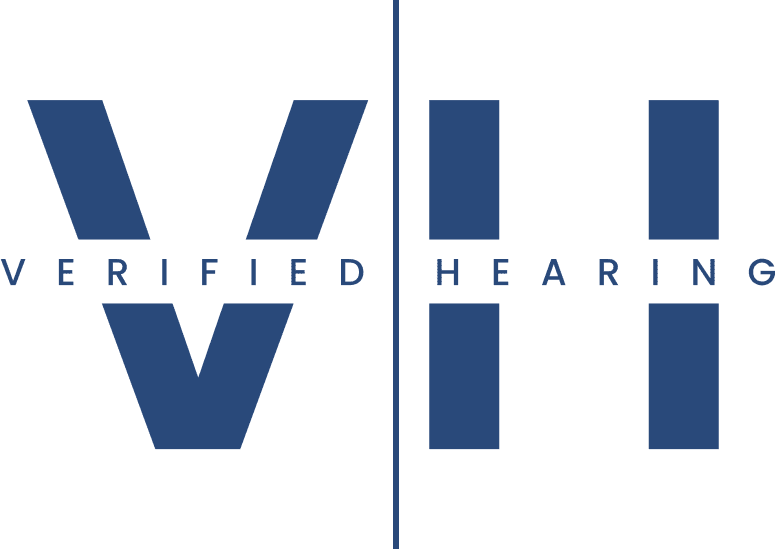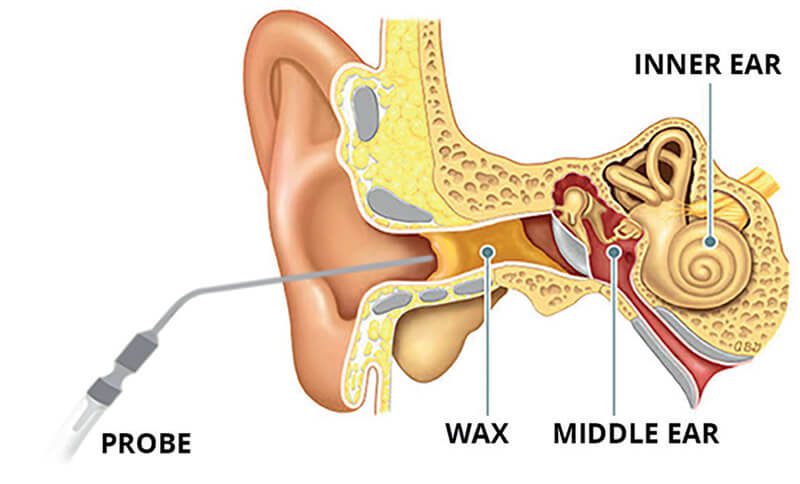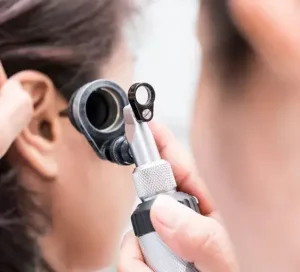In many cases, ear wax can be harmless, posing no real danger, as there are natural mechanisms which ideally should take care of it. The ear is naturally self-cleaning. When dead skin from the inner ear begins to migrate out, it naturally pushes out old ear wax as it is coming out. But sometimes, things go awry, and this natural process gets halted. Ear wax can build up as a result of this, and many upsetting symptoms would be the result. Pains in the ear(s), hearing loss, a ringing sensation in the ear (tinnitus), and dizziness are some of the symptoms you could notice.
When you notice these symptoms, seeking professional help is the wisest thing to do. Trying your hands at home remedies when you are not trained for this is dangerous. You could suffer lacerations, or more serious injuries in the process or even get infected. You should book a check with your professional audiologist for informed advice. Depending on findings, your audiologist or GP could choose from several professional procedures that are safe, such as Microsuction ear wax removal to get wax out of your ear.
What is Microsuction Ear Wax Removal?
Microsuction is a compound word referring to two of the primary machines used during this procedure. While ‘Micro’ is derived from the word microscope which is the viewing mechanism used during this procedure, ‘Suction’ refers to a machine used in sucking out wax from the ear. Microsuction ear wax removal then, is a clinical process in which the clinician uses a single-use probe, connected to a suction machine set at low pressure to remove ear wax while viewing the ear canal through a microscope to get a clear view of your ear canal.
How does Microsuction Earwax Removal Work?
Procedure/Steps:
At the outset, the clinician examines the ear by gently inserting a speculum and then viewing your ear canal through a microscope, and determines if this will be the best procedure. A single-use probe connected to the suction machine is set at a safe pressure level. While viewing the ear canal with a microscope the ear wax is sucked out of the ear canal until the eardrum is fully visible. In some cases, the patient will be given access to have a view of his ear canal prior to commencement of the procedure. The whole process takes a few minutes. This method is favoured for its speed, safety, and minimal risk of ear infection. Most people report that the process is painless.
Microsuction is often considered more comfortable and less messy than traditional methods such as manual ear syringing, and it is suitable for most individuals, including those with perforated eardrums or a history of previous ear surgeries.
Advantages of Using Microsuction
Many people wonder if the Microsuction method of ear wax removal is safe, and why it is chosen sometimes. As mentioned above, Microsuction is very safe. Since it is a dry procedure, you could toggle between the procedure and other activities of the day without any lasting messy effects, and it bears very minimal risk of infections for the same reason. Many patients report relief from symptoms such as hearing loss, ear pain and tinnitus after the procedure.
Potential Risks/Side Effects of Microsuction Ear Wax Removal
In rare cases of ear sensitivity due to thinning of the skin of the ear canal after prolonged use of cotton buds or certain ear drops, discomfort, or trauma to the ear could be recorded during this procedure. Also, trauma to the ear may occur due to sudden movement of the patient leading to the probe touching the skin of the canal.
Other side effects might include Dizziness, Noise damage, and ear infections. It is possible to feel a little dizzy after the procedure because the process actually reduces the temperature of the ear canal. This might have a dizzying effect. This feeling should not last long after the procedure as ear canal temperature quickly gets back to normalcy.
Noise damage might be reported because the suction machine can be quite loud. Some people might find this noise disturbing, and this could lead to temporary hearing loss. Again, this should be temporary and should not be viewed with too much concern. In very rare cases, tinnitus may occur, and this should be short-lived. We mitigate these by limiting the amount of time for the procedure.
The probe that goes into the ear during this procedure is single-use, and as a result, infection due to this Microsuction ear wax removal is very rare. However, if it does occur, there are very effective measures or treatments that could clear up the infection.
It is important to emphasise that because of the rarity of these cases, they should not be cause for any serious concern.
Microsuction Ear Wax Removal at Home
If you are unable to attend our microsuction clinic, we offer home visits and will be happy to see you in the comfort of your home.
Microsuction Ear Wax removal FAQs
Below are some of the frequently asked questions concerning Microsuction Ear Wax Removal:
Yes! It is one of the safest methods of removing ear wax.
No. It is mostly a painless procedure. However, precautions against this are usually taken before the procedure begins. A one-word caution may be agreed upon between clinician and patient to stop operation as soon as any pain is felt. As simple a word as ‘stop’ could be used as a signal to halt the procedure. In most cases, they do not end up being used because the process is mostly painless.
Time between ear wax build up for individuals varies, but irrespective of how recently you have had a microsuction or any other ear wax removal procedure, if you notice earache, tinnitus, or hearing loss, you should visit the clinic for a check and an informed advice.
General possible risks of scratch to the ear, tinnitus, dizziness and even perforation of eardrum exist. But these risks are so far-fetched that you do not need to worry about them.
Yes! It is important to soften your ear wax with ear drops before microsuction. Among the many products available, we recommend only olive oil ear drops or sprays such as earol. Olive oil lubricates the ear canal and wets the ground for ear wax to easily slip out during ear microsuction. Ear Drops such as sodium bicarbonate, hydrogen peroxide, and saline base drops should only be used for very hard wax and for a limited period.
It is a bit of a game of chance now. Some areas offer ear microsuction with a long waiting list, while others do not at all. To be sure, find out from your local GP if the service is available. If you’re unable to access this service, private clinics like ours are always at your service.
Microsuction Ear Wax Removal Videos
With several hours of YouTube videos about Microsuction sessions, there is no shortage of visual content around this subject. If you are drawn to visual contents, then you might find the following Microsuction ear wax removal videos helpful for your learning journey or just to satisfy curiosity. Warning! Do not watch if you’re squeamish.
Ear wax removal video. Warning! Do not watch if you’re squeamish.
Video from Verified Hearing
Ear wax removal video. Warning! Do not watch if you’re squeamish.
Video from Verified Hearing
Ear wax removal video. Warning! Do not watch if you’re squeamish.
Video from Verified Hearing
Our Microsuction Ear Wax Removal Reviews
What our patients say about microsuction.
 Anthony Richardson2023-08-11After trying numerous places for ear wax removal over the years this is by far the best there is. So convenient and service is second to none. Wouldn’t recommend anywhere else.
Anthony Richardson2023-08-11After trying numerous places for ear wax removal over the years this is by far the best there is. So convenient and service is second to none. Wouldn’t recommend anywhere else. Michael Rothwell2023-08-08exceptional service and MJ (audiologist) was great
Michael Rothwell2023-08-08exceptional service and MJ (audiologist) was great Dolores Armstrong2023-07-25
Dolores Armstrong2023-07-25 Raphael Gruber2023-07-22Super friendly. Quick and easy. Perfect results. Actually looking forward to coming back
Raphael Gruber2023-07-22Super friendly. Quick and easy. Perfect results. Actually looking forward to coming back Ralph Allwood2023-07-19
Ralph Allwood2023-07-19 Cassandra O'Leary2023-07-16So happy that we found this Audiologist. Excellent with children, very friendly and welcoming. Myself and my daughter are very happy with our appointment.
Cassandra O'Leary2023-07-16So happy that we found this Audiologist. Excellent with children, very friendly and welcoming. Myself and my daughter are very happy with our appointment. Eric Walter2023-07-12A great first time experience, very informative procedure and carried out the work in a first class environment and would definitely go back in six months .
Eric Walter2023-07-12A great first time experience, very informative procedure and carried out the work in a first class environment and would definitely go back in six months . Brython Caley-Davies2023-07-11
Brython Caley-Davies2023-07-11 Simona Zajicova2023-07-11The doctor was very nice. He checked my son's ears, but there was no microsuction needed. My son had no earwax in his ears that needed to be removed. Therefore, I don't understand why I was charged £120 for something that was not done. In cases like this, clients should get some of their money back, don't you think? It's common in other clinics.
Simona Zajicova2023-07-11The doctor was very nice. He checked my son's ears, but there was no microsuction needed. My son had no earwax in his ears that needed to be removed. Therefore, I don't understand why I was charged £120 for something that was not done. In cases like this, clients should get some of their money back, don't you think? It's common in other clinics. Marcel Vandenbussche2023-07-07Google rating score: 4.8 of 5, based on 82 reviews
Marcel Vandenbussche2023-07-07Google rating score: 4.8 of 5, based on 82 reviews
References:
Microsuction ear wax removal potential side effects/FAQs. March 8, 2021
https://www.healthline.com/health
/microsuction
Accessed: Aug. 26, 2023
https://www.healthline.com/health/microsuction
Accessed: Aug. 26, 2023




